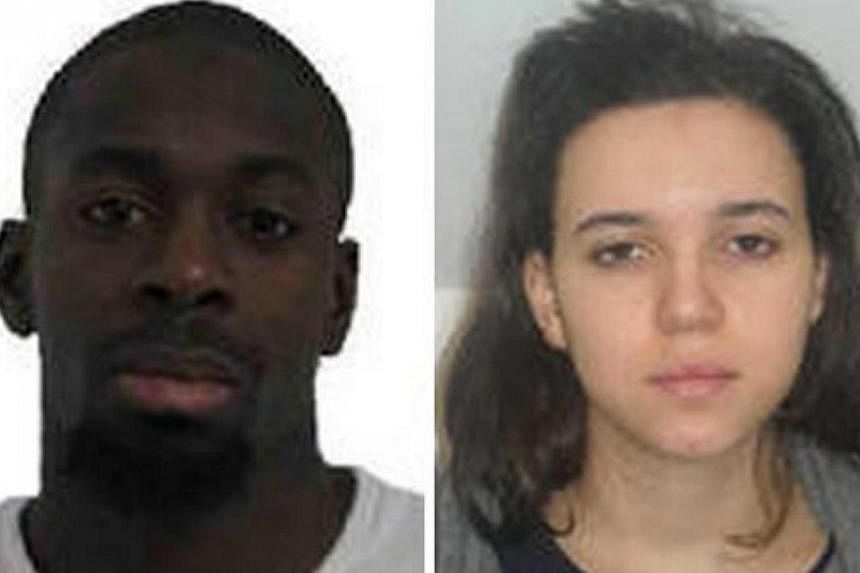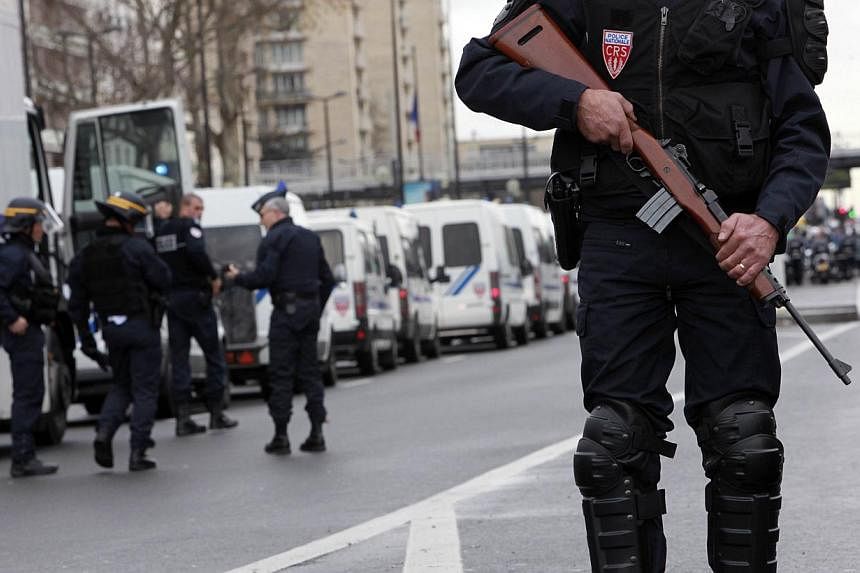PARIS - Two hostage situations unfolded in France on Friday, widening a security nightmare that gripped the nation since a shooting at French satirical newspaper Charlie Hebdo on Wednesday morning.
French police have now said that the two attacks - at a kosher supermarket in Porte de Vincenne, and a printing shop in Dammartin-en-Goele are linked.
AMEDY COULIBALY AND HAYAT BOUMEDDIENE
In the first ongoing hostage situation, several people were taken hostage at a kosher supermarket in eastern Paris on Friday, after a shootout involving a man armed with two guns. He was identified by French police as Amedy Coulibaly, 32.
He reportedly told police: "You know who I am and I'm going to keep these hostages until the siege in Dammartin is lifted."
French police released mugshots of Coulibaly and a woman on Friday.
The woman, Hayat Boumeddiene, 26, is apparently the girlfriend of Coulibaly. They are considered "armed and dangerous", police said.
Coulibaly knew at least one of the suspects in the Charlie Hebdo massacre, a source told AFP.
Coulibaly was seen with Charlie Hebdo suspect Cherif Kouachi in 2010 during an investigation into an attempted prison break in France. Coulibaly was convicted for his role and was well-known to anti-terrorist police.
He is also suspected of killing a policewoman in a southern suburb of Paris on Thursday.
Meanwhile, in the second hostage situation going on in the town of Dammartin-en-Goele, near Charles de Gaulle airport, French elite forces deployed snipers on roofs and helicopters buzzed low over a small printing business where the Charlie Hebdo suspects were holed up with a hostage.
Security forces laid siege to the CDT printing business where brothers Said and Cherif Kouachi are holed up.
CHERIF KOUACHI
Cherif Kouachi, then aged 22, was featured in a 2005 documentary about France's extremist youth, he was portrayed as being more interested in girls than religion.
In the video, he is dancing and rapping, dressed in a sweatshirt, baggy jeans and a baseball cap worn backwards.
The 10-year-old clip was shown widely on French television channels a day after the shooting of 12 people at the office of magazine Charlie Hebdo.
Born to Algerian parents and orphaned at a young age, Cherif and Said Kouachi grew up in an orphanage in the western city of Rennes.
When he moved back to Paris later, he delivered pizzas, and dreamt of becoming a rap star.
He then fell under the sway of Farid Benyettou, a self- proclaimed spiritual leader. Cherif began going to prayer classes. He started watching Jihadist videos and grew his beard.
He was arrested in France in 2005 just as he was about to leave for Syria. His eventual destination was Iraq, where he hoped to fight in a militant cell.
He was convicted three years later and released in 2008 for time served.
In an interview shortly after his arrest published by the Pittsburgh Tribune, his lawyer Vincent Ollivier said Kaouchi, then 22, was not particularly religious.
"He drank, smoked pot, slept with his girlfriend and delivered pizzas for a living," the newspaper reported.
After his release, Cherif found a job selling fish at a supermarket, while renewing contacts with his old comrades. He was linked to, but never prosecuted for a plot to free a jailed Islamist militant.
The manager of the supermarket told The New York Times Cherif made an excellent fishmonger. She said he was conscientious and the only thing he ever talked about was the price of fish.
French anti-terror prosecutor Jean- Louis Bruguiere thought he was "small fry" when he popped up on their radar years ago, but he told Bloomberg: "The silent ones are those who go rogue."
SAID KOUACHI
His brother Said Kouachi has no previous convictions, but French interior minister Bernard Cazeneuve told the New York Times it appears that Said, 34, was the driving force behind the massacre.
The elder brother laid low, and has never been prosecuted or convicted, though he was linked to the cases involving his brother.
He went to Yemen for religious studies in 2011.
Said was among a number of foreigners who entered the country for religious studies. "We do not have confirmed information that he was trained by al-Qaeda but what was confirmed was that he has met with Awlaki in Shabwa," a source, refering to al-Qaeda preacher Anwar al Awlaki.
US-born and web-savvy Awlaki was seen as an influential international recruiter to the al-Qaeda movement and a prominent figure in Al-Qaeda in the Arabian Peninsula (AQAP), the group's most active affiliate. He was killed in September 2011 in a drone strike widely attributed to the CIA.
After Said returned to France from Yemen, both brothers appeared to have refrained from any activities that might have drawn the attention of French law enforcement or spy agencies.
Both were listed in two US security databases, a highly classified database containing information on 1.2 million possible counter-terrorism suspects, called TIDE, and the much smaller "no fly" list maintained by the Terrorist Screening Center, an inter-agency unit.



